Autumn foraging is a fun way to source delicious and nutritious food for free. Here is a guide to seven easy-to-find autumn foods to look for.
1. Blackberries
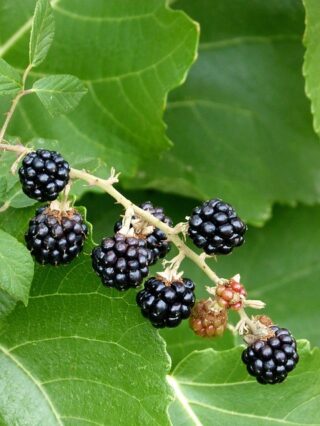
Most of us are already familiar with blackberries, and you’ll also often find them on supermarket shelves at ridiculously high prices, much like other soft fruits.
Blackberries are in season during late August and through September, and often there are still some that are good to pick during October.
The fruit is easy to recognise, and because they are so distinctive, there is little to confuse them with, other than a raspberry when in an unripe state.
Blackberries are fun to pick, and are a great way to start a love of autumn foraging. Children especially love picking and eating the fruit. You just need to be a little careful of the thorns.
Identifying Blackberries
Blackberries can usually be found in hedgerows that form field boundaries, woodland, edges of paths and roads, and wasteland in both countryside and urban settings.
Brambles come out in white flowers that appear in early summer, followed by clusters of fruit, known as drupes. Small green berries grow and turn red, then they ripen to a dark purple black.
Blackberries grow on bramble vines that have long, arched and spiky stems that trail to the ground. Once they reach the ground, the stems can take root, eventually forming thick and spreading patch of brambles.
The fruits always grow in clusters, rather like a miniature bunch of grapes, so if you see a single berry that is the same colour, it is not a blackberry, so don’t pick it.
The leaves of the blackberry plant are oval shaped with pointed tips. They have serrated edges and grow alternately along the stem.
Blackberry Picking Tips
Wear old clothing – Blackberry juice stains, so wear old clothing.
Watch out for thorns! You are also likely to get caught on thorns here and there which could put holes in your clothes. Brambles thorns are very sharp so take care when picking. Wear long trousers rather than shorts so you can stand amongst the brambles to get the best fruit. Long sleeves will also minimise getting scratched by thorns.
Use a hooked stick to reach higher stems and bring them lower to allow easier picking. Ripe berries should come off the plans with a slight tug. If it doesn’t, then leave it on the plant to ripen further. Under ripe blackberries are rather sour, so not worth picking.
The tastiest berries are the ones that have ripened in full sunlight, so go for plump, dark berries you can see that are in the sunshine.
Use a container rather than a bag, as blackberries bruise and squash easily.
Storing Blackberries
When you get your blackberries home, don’t wash them until right before you use them, otherwise they tend to turn to mush. Keep freshly picked blackberries in a fridge and eat within 24 hours.
The keep them for longer, try tray freezing. Spread blackberries out on a tray and freeze. Once frozen they can be put in a bag, so you have lots of individual fruits ready to be used, rather than a block of frozen berries.
Nutritional Values of Blackberries
Raw blackberries are a great source of vitamins, such as vitamin C and K.
Vitamin C is good for a healthy immune system. Vitamin K is important for strong bones as well as helping blot to clot after injury, and getting enough of this vitamin in your diet can help prevent conditions such as osteoporosis and blood thinning.
Blackberries also have high levels of antioxidants that help protect the cells in the body from damage. This makes them a great choice for helping to prevent diseases and to slow down the effects of ageing. The fruit also provide dietary fibre, helping you have a healthy digestive system.
The leaves of bramble plants also have a host of health benefits, and also provide antioxidants, vitamins and micro-nutrients that are good for health. Blackberry Leaf Tea is an old remedy that is used for it cleansing properties, as well as being a remedy to treat sore throats and diarrhoea.
How to make Blackberry Leaf Tea
Gather the younger leaves. At home, gently squash them to release some of the juices, wrap in a tea towel and put in a sunny spot such as a windowsill for a day or two. This acts as a fermenting process that gives a stronger flavour to the tea, as well as enhancing the therapeutic effects.
Once you notice a pleasant floral scent coming from the leaves, spread them out to dry. This may take another day or two. Once completely dry, you can crumble the leaves and store in an airtight container, ready to use as a tea whenever you wish.
To make blackberry leaf tea, take two teaspoonfuls of leaves and add boiling water. Allow to brew for 5-10 minutes. Strain and enjoy! The taste is light and refreshing, and a little like the bergamot flavour of Earl Grey tea.
Blackberry Wildcrafting and Folklore
The stems of brambles with the spikes scraped off were commonly uses to weave baskets or make cordage, having the advantage of being flexible and strong.
As well as being a healthy drink, Blackberry leaf tea can be used cold as a topical treatment for wounds, thanks to its astringent and anti-inflammatory properties.
Old folklore says, do not eat blackberries picked after October the 11th as the Devil has spat on them! It is said that the devil was cat out of heaven on St Michaelmas day and landed in a patch of brambles, so any blackberry picked will be thin and have no flavour. Interestingly, this time of year is when the weather becomes colder, and could be the reason why late season blackberries are past their best.
Blackberry Recipe Suggestions

Crumbles and Pies
Blackberry sorbet
Jams
Wine
A wild fruit sauce to go with red or game meats.
So, that is an overview of the blackberry, one of the best autumn foraging fruits and powerhouse of nutrition.
2. Crab Apple
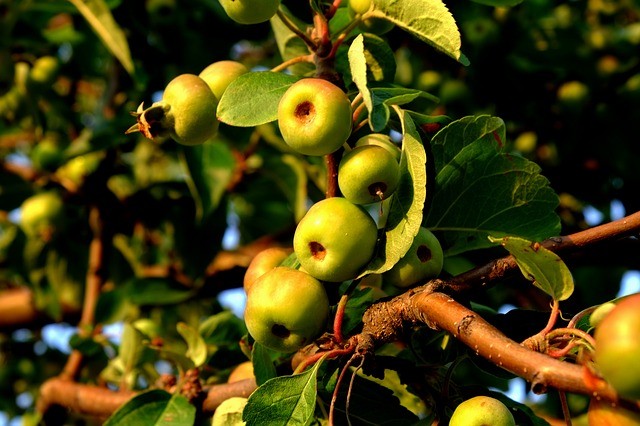
Crab apples are small wild apples that are common in the UK and the rest of Europe, as well as the United States. Think of crab apples like the ancestors of our cultivated varieties, which have been developed over the years to produce larger, sweeter fruits.
Now if any of you have ever tasted a crab apple, you’ll know it for its sour, mouth drying apple flavour. You might be wondering why you should forage for crab apple when they taste so sour, but actually, there are lots of ways to use crab apple in a variety of dishes, and can be treated much like cooking apples.
Crab apple fruits appear from late summer to early winter, and are abundant crop for autumn foraging.
So how do you know if it is a crab apple you’re picking and not something else? Well, here’s how.
Identifying Crab Apples
Crab apple trees are small in size, and grow with a twisted and gnarly look to them. Mature trees can reach up to ten meters, but they are often smaller and have an irregular, scruffy shape to the canopy, adding to the crabby, almost hunched appearance.
You can often find them growing in hedgerows, woodland and wasteland. Sometime they are found growing in green park areas too, such as village greens or urban and suburban parks, as well as street corners and back gardens.
Crab apple trees blossom in spring with five petal, white to pink flowers, this is then followed by growing fruits. The leaves are small, dark green and oval shaped.
Crab apples vary in size, shape and colour, but essentially they just look like miniature versions of eating apples. They can ripen to red, golden and green hues, just like cultivated apples, and if you cut across the core horizontally, it reveals a star shaped centre where the pips are.
Crab Apple Picking Tips
Make sure fruit is ripe. Timing is everything when picking crab apples. You want them ripe for the best taste, but not under ripe or over ripe so they begin to rot. A good way to judge is when you see some apples around the tree that have fallen to the ground. This is an indicator that the rest are ripe or nearly ripe.
Taste it – the flesh of a crab apple should be firm, but not so hard that you struggle to bite it! The taste should be sour with a hint of sweetness. If it tastes bitter then discard.
Check the pips – another way to tell if a crab apple is ripe is to cut it and look at the pips. If they are brown, the apple is ripe.
Storing Crab Apples
Keep in a cool place with air circulating around each apple.
Freeze – crab apple freezes well if you make them into a puree by stewing. You can also freeze them whole. Remove the stems and flower ends first and place on a tray to freeze. You can them put them in bags to use when you want to.
Nutritional Value of Crab Apples
The saying goes, ‘an apple a day keeps the doctor away’, and rightly so. Both cultivated and wild apples can greatly benefit your health. Crab apple contain vitamin C and B, and also a wealth of antioxidants and tannins that may help prevent a range of conditions.
Crab apples are also very high in pectin, which has been shown to be beneficial in reducing cholesterol and heart disease.
Good source of malic and tartaric acid, known to be beneficial in treating conditions like gout, fever and inflammation.
One thing to note is that all apple pips, both cultivated and wild, contain small amounts of cyanide. However this is not something to worry about. Just don’t eat the pips. Even if you did eat them, they would usually pass through the system complete without releasing any of the chemical.
Crab Apple Wild-Crafting and Folklore
Apple wood, when cut and dried, becomes very dense and hard, making it great to use for a variety of purposes, including woodcarving and turning.
Apple firewood burns long and slow, and is a long lasting fuel to warm you through chilly evenings. It also smells pretty good too! Chop it into logs when freshly cut, as it becomes much harder to work with when dry. Crab apple bark chippings are great for smoking foods, from cheeses to meats, adding a sweet smoked flavour.
A yellow dye can be extracted from the bark of crap apple trees, and used to colour wool and fabric.
Crab apples have also been used as a medicine. Traditional apple preparations were used to treat gout and digestive problems such as constipation. Raw apple poultices were used to treat skin or wound inflammations.
Crab Apple Recipe Suggestions
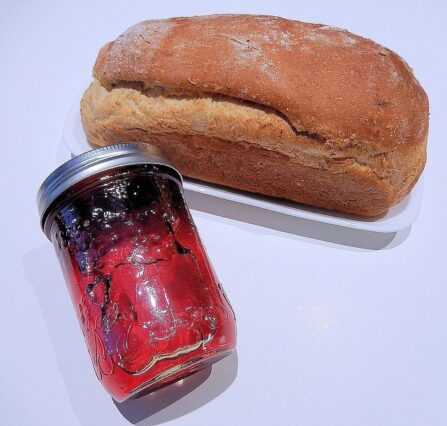
You can use crab apple much like cooking apples, but due their small size and sour flavour they’re best added alongside other fruits for pies and crumbles. For example, you could add a few crab apples to your foraged blackberries, or wild plums for a tasty autumn fruit crumble.
Jellies and Jams – crab apples are great to add to jellies and jams because they are full of natural pectin, which is the stuff that makes it set. Even just adding a little crab apple to another fruit when jam making is enough to make it set, without the need for shop bought pectin. Jellies made from crab apple make a delicious accompaniment to meats.
Cider – Crab apples are great for home-brewing, but if you just use crab apples for cider making, you may create cider that’s an acquired taste. However, adding some crab apples to cultivated ones for cider making adds an interesting flavour. Aim for about 10% crab apple for a tasty, wild flavoured brew.
Stewed Apple – another way to use crab apples is to simply remove the cores but cutting down four sides, leaving just chunks of crab apple. Put in a pan, cover with water and gently simmer until you have a lovely apple pulp. This can then be separated into portions, and put in the freezer for you to use as you wish. Sweeten and add to fruit pies and pastries, add spices to make a sauce for meats, or use a little to liven up a casserole!
So there we have the humble crab apple. Next time you see a crab apple tree full of fruit, make sure you take some home with you for some culinary experiments!
3. Elderberries
Now there are lots of things you can do with this plant, including recipes using the flowers, but during late summer and autumn it is the berries that are ready for harvest. Now, there are loads of uses for this fruit, so it is one of the highlights of early autumn foraging.
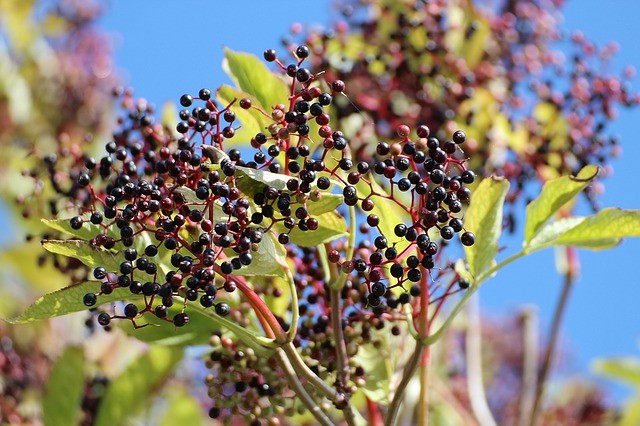
How to Identify Elderberries
Elderberries grow in many many places in both countryside and urban settings, and are actually part of the honeysuckle family. No matter where you live you are sure to find some growing close by. Good places to look are parks and footpaths nearby and you are sure to find elderberry. You’ll also often find them in hedgerows that divide fields.
Elderberries begin red and then ripen to black during late summer and early autumn. The berries have a tart flavour, and are reminiscent of the taste of a blackberry.
The fruit grows on bushes in hanging clusters, following white umbral shaped flowers. Each berry is around 4ml in diameter and grows singly, but the clusters can be up to 30cm across.
The young stems are green and mature to grey as they mature, and they have distinctive specks on them. When split there is a soft, cork like centre that if removed it leaves a hollow tube.
The leaves are dark green and serrated, and arranged in opposing pairs with one at the top. They give an unpleasant smell if crushed.
Caution! Do not eat elderberries raw as it can cause digestive upset – I speak from experience here as when I was a child I ate loads of elderberries straight from the bush and spent the afternoon feeling sick!
It is only the flowers and berries of this plant that are edible. The leaves and stems of elderberry are toxic, so don’t use them.
Elderberry Picking Tips
Pick the ripe berries only, ones that are dark purple to black. Not only do they have the best flavour as this is when they are soft and juicy, but unripe berries can cause stomach upsets. Unripe berries are hard and don’t come off the stalks so easily, so leave them on the bush to ripen further.
Picking elderberries can be quite time consuming due to their small size, but you could use scissors to snip off whole clusters and the pick off the berries when you get home, or there are berry pickers that are designed to scoop individual berries from the stalks. Some people find these useful, but I personally prefer to take then clusters home as I can get the berries off intact, without squashing them.
Nutritional Value of Elderberries
These little black berries are bursting with vitamin C, and are one of fruits that contain the most, alongside rosehips and currants. They also have high amounts of vitamin A, and minerals such as iron, copper and potassium, as well as a good dose of daily fibre.
Like other dark fruits, elderberries have lots of antioxidants, including flavonoids that are key to keeping healthy cell production in the body, as well as clearing those free radicals that cause stress to our cells over time.
Elderberries also have ant-viral properties, so eating them, or making a decoction or tincture from them, can help to shorten the duration of viral illnesses. Elderberry is also an expectorant, meaning that it encourages the expulsion of phlegm and mucus, so probably why it is said to help with symptoms of colds.
Elderberry Wild Crafting and Folklore
Traditionally, elder was seen as a protective plant, and if it grew on your property it was said to keep evil spirits at bay. People would sometimes hang a bunch of elder stems outside their homes also to keep bad spirits away.
The spongy centre of elder stems is easy to remove, leaving a hollow centre. This made them valued material to make all sort of tools, like pipes to blow air onto a fire.
They were used to make wind instruments like pipes and flutes, and the official name for Elderberry, ‘Sambucus’ may have been derived from a word that means wind instrument in Greek, or a harp like instrument in Latin.
Elderberry Recipe Suggestions
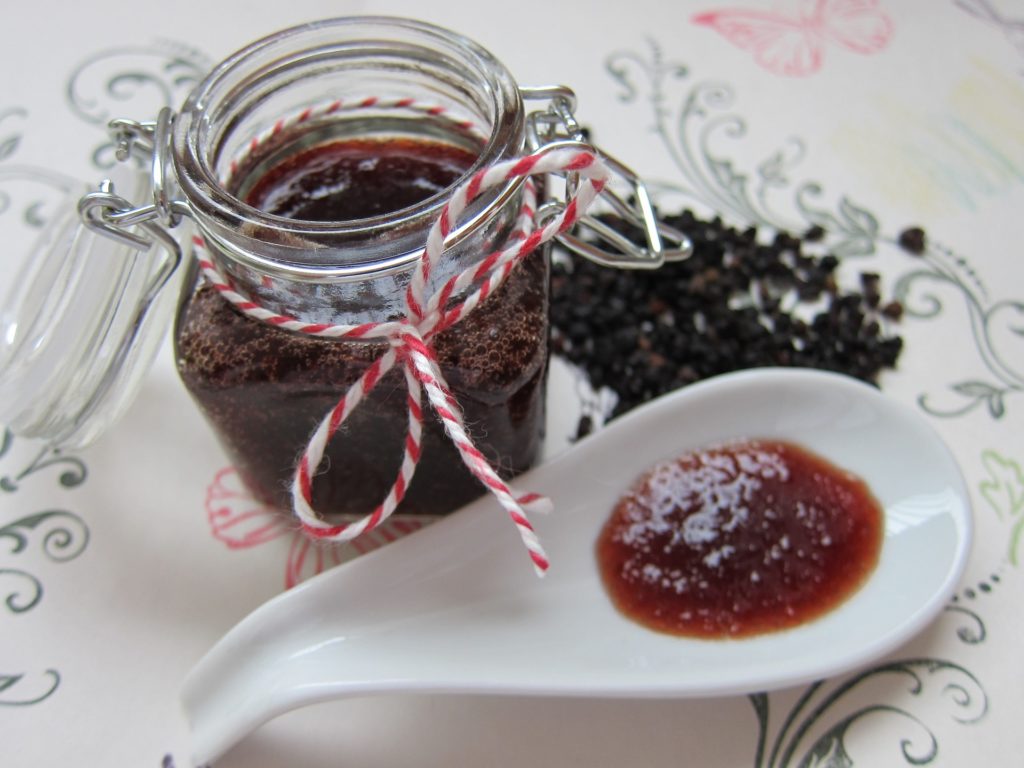
Cooked elderberries lends itself well to fruit sauces that can be used with sweet or savoury dishes. Try stewed elderberry with a little sugar added, and drizzle over ice cream or use as a sauce for red meats.
Jam is another popular use for this versatile fruit.
Add yeast and sugar to pressed elderberries to make a homemade wine.
A healthy drink can be make from simmering elderberries in water for 30 minutes. You might also like to add another fruit, such as apple or pair – anything that will help sweeten the liquid without the need for added sugar. The juice can be strained, or not, depending on your preferences. Pour into sterilised glass bottles and keep in a cool place. Once opened, drink within a few days.
So there we have the elderberry, a fruit that is so much more than an ingredient we use to make jam. If you haven’t used elderberry before, get out there and collect some and enjoy all the nutritional benefits and flavour it brings!
4. Hawthorn
Hawthorn is an abundant hedgerow plant that can be found growing all over the temperate regions of the Northern hemisphere. The fruit of the Hawthorn are often called Haws, and this plant has been a staple source of food and medicine for millennia.
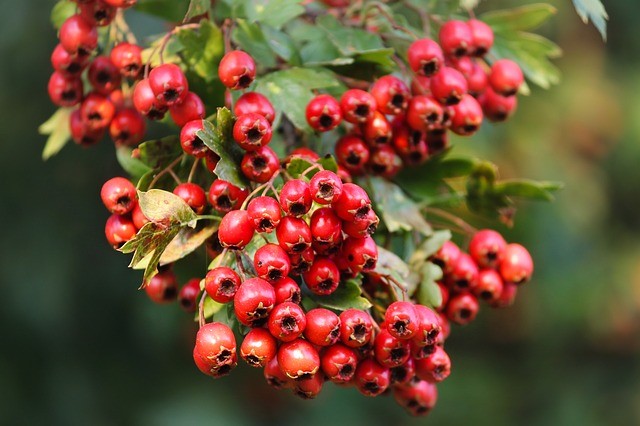
How to Identify Hawthorn
Hawthorn can usually be found as hedgerow forming shrubs that separate fields that grow alongside country roads and footpaths, but they can also grow as a single tree.
The white flowers blossom in late spring, and are followed by red berries, called Haws, that ripen during the autumn. Haws are small, and oval shaped. They grow on a single stem and have a point on the bottom that looks a little a tiny dry flower.
The leaves have a deep, toothed appearance with rounded edges, and sit on single stems.
Hawthorn Picking Tips
Just as with Sloe berries, Haws taste much better after they have had a frost or two on them.
Pick the plumpest looking berries by plucking them off the stems. Avoid any that have been nibbled or have spots on them.
Pick carefully, as twigs can be sharp.
Nutritional Benefits of Hawthorn
Hawthorn berries are rich in vitamins A, C and E. They also have flavonoids, antioxidants that clears toxins from the body as well as boosting the immune system.
Haws are known for their benefits for the heart. The antioxidants it contains help to improve poor blood flow, lowers cholesterol and prevent chest pains. They may also be effective at lowering blood pressure, due to its dilating effects of the blood vessels. Various studies have been conducted into the use of hawthorn for heart health, with promising results for a number of heart related conditions.
CAUTION: Before taking hawthorn medicinally, check with your doctor or health care professional as hawthorn is known to interact with prescription medications that treat the heart.
Hawthorn is also good for keeping your digestive system healthy, by increasing the amount of bile produced and easing the digestion of fatty foods, or high protein foods.
Some people report feeling relaxed and sometimes sleepy after eating hawthorn berries, and this mild sedative effect may be helpful for symptoms on anxiety and depression.
Hawthorn Wild Crafting and Folklore
Hawthorn wood is dense, and is a good material for making small carved items that need to last, like tool handles. The wood also produces lots of heat when burned.
In folklore, hawthorn is a tree that is associated with death. When in bloom, the flowers produce a chemical that gives a scent of decay, the same as when flesh is decomposing!
It was also said that the smell of hawthorn flowers is the same as the smell of the bubonic plague that wiped out over a third of the population of Europe in the mid 1300’s onwards, again, this could have been because of the decay of dead bodies at the time. That is why it has always been taboo to bring hawthorn flowers into the home, although they were used outside for May decorations.
On a lighter note, hawthorn trees have often been thought of as faerie trees, where these small mythical creatures lived, and in the UK were often left uncut.
It is also said that if there is a large crop of haws, then following winter will be a cold one.
Hawthorn Recipe Suggestions
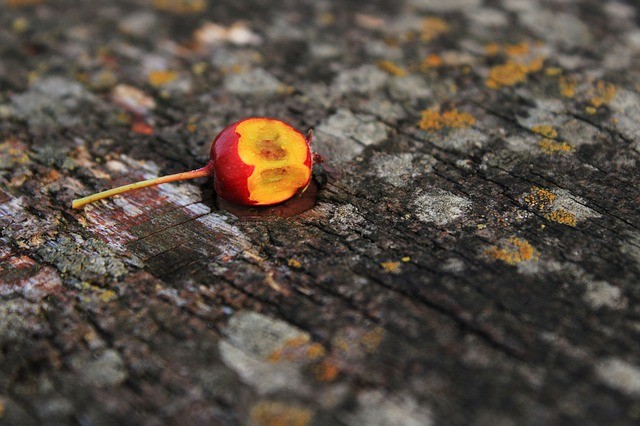
Young hawthorn leaves, often known as ‘bread and cheese’ are a tasty addition to salads adding a nutty flavour, but it is the berries that are ready to collect in autumn.
The texture of a haw berry is rather dry, with a texture that is similar to avocado, rather than being juicy, and the flavour is mild with a hint of both sweet and sour.
You can make a healthy tea by infusing hawthorn leaves and berries in boiling water for 10 minutes before straining.
One way to use haws is to simmer them in a pan of water for 20-30 minutes, then strain the liquid through a cloth. You then have a delightful hawthorn decoction that can be used as a base many dishes.
Being full of pectin, Haws are great for jam making as it will make a jam, or jelly, that will set naturally without the need for added pectin bought at a store. You can also make a delicious fruit leather that is great to carry with you when you go hiking, or as a long lasting sweet treat to keep in your cupboard.
It is important to note that just like apple seeds, hawthorn seeds contain cyanide and should not be consumed. Haws have a single seed in each berry, so they are easy to remove, or just spit them out if you are eating them raw.
There is so much more we could talk about for this abundant autumn berry, especially recipes which are a favourite of mine!
Are you interested in the idea of foraging, but are not sure how to start?
Have you been wondering what you can actually cook with the wild foods you have gathered? Or, what the medicinal benefits are for each fruit or plant?
Get your copy of Foraging for Health here.
5. Rosehips
Rosehips are the fruit that forms after rose plants hove flowered, and for foragers this mean wild species of roses, such as the wild dog rose and field rose, that grows abundantly across Europe, North Africa and also west Asia. Cultivated roses also produce hips that are edible, and are often much larger, however, the flavour is not nearly as good as wild rose hips
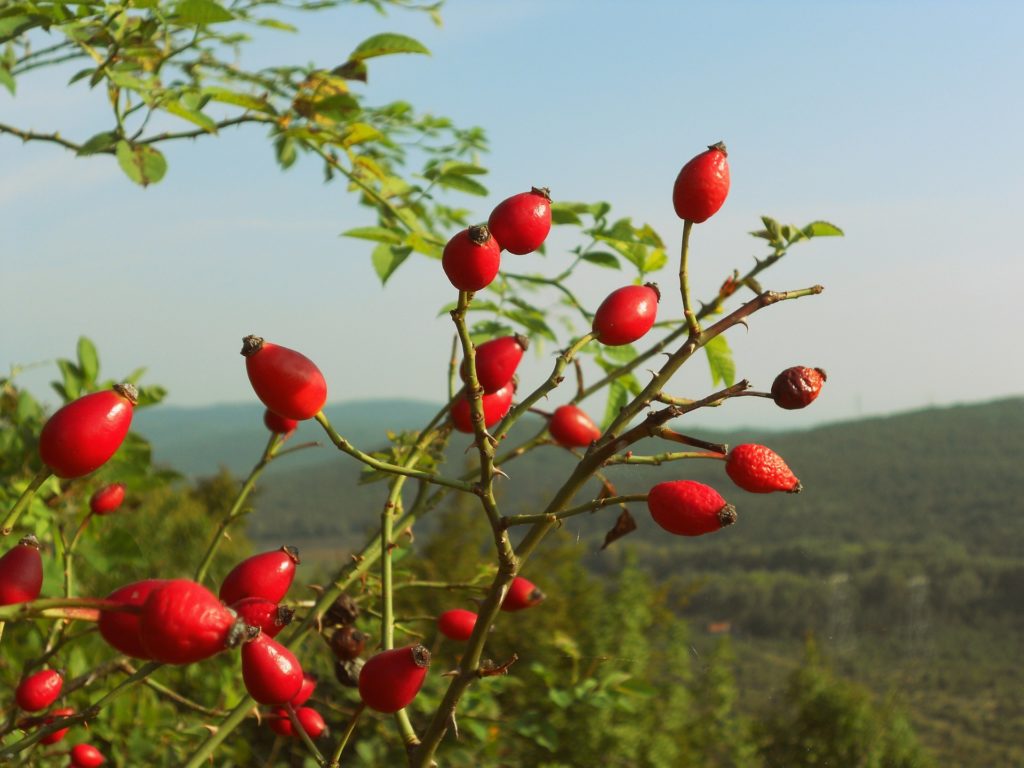
You often see rosehips glowing red in the hedgerows during late summer, autumn and early winter, and it is a plant that has been used as a food and medicine for thousands of years.
Identifying Rosehips
Wild Rose flowers have long stems and flowers with five petals, usually pale pink in colour with yellow stamens. After flowering a green rose-hip is produced that ripens to red.
The hips are usually about half an inch in length, but this can vary depending on the location of the plant.
The leaves of wild roses on thorny climbing stems. They are oval shaped with serrated edges, like cultivated rose plants.
The roses that grow in your garden will also produce hips, and they will be much more rounded, larger and fatter than their wild cousins. They are also edible, however they do lack the flavour of the wild rose hips.
Rosehip Picking Tips
It is said that rosehips taste sweeter after the first frost, as frost tends to soften the flesh of a fruit and break down the cell walls, making them juicier. But don’t worry if can’t wait that long, they still have a delicious sweetness. You could also pick them and put them in your freezer overnight to mimic a frost!
Choose hips that are full looking and rounded, avoid any that look dry or mouldy
Picking rosehips can cause some skin irritation due to tiny hairs on the seeds.
Storing Rosehips
Rosehips can be used fresh, or dried to keep a long-lasting store to see you through to the next season.
Dried rosehips are easy to make tea with. Drying rosehips is really simple, and makes removing the hairs really easy.
How to Dry Rosehips
Gather plenty of rosehips, so you will end up with a good amount to store. Wash them and take off the stalks.
To dry, use a food dehydrator. These handy items make it easy to dry and preserve any food. If you don’t have one, you can spread rosehips out of a tray and put in a warm oven, leaving the door open to allow moisture to escape. This may take a few hours.
Another method of drying is to simply leave them in a basket or tray, and leave them for around ten days. You will have to move the hips around daily, but it is a good method if you are not in a hurry.
Once the rosehips are dry, put in a food processer and roughly chop. You want a fairly coarse mixture, giving you nice pieces of rosehip, rather than a crumb!
Get a sieve, and add a handful of the dried rosehips. Shaking the sieve will let all the fine hairs fall through, leaving the chunkier pieces of dried rosehips behind. Store in an airtight container, and use when you wish.
Nutritional Benefits of Rosehips
Rosehips are full of antioxidants, and vitamins C, B and A. In fact, they have more vitamin C than citrus fruits. Because of their impressive vitamin C content, rose-hips were collected and made into a syrup to help keep the nation healthy during the Second World War.
The vitamin C content make rosehip helpful in strengthening the immune system, helping to fight off symptoms of cold and flu. However, to get the best effects, the fruit should be eaten fresh.
The nutritious rosehip has also been used as a treatment for stomach ulcers, diarrhoea and cholesterol problems. There is also promising evidence that rosehip could be effective in treating pain and inflammation to do with osteoarthritis.
Rosehip Wild Crafting and Folklore
The seeds make an excellent itching powder that many country children used to enjoy teasing each other with. The trick is to spilt open a few rosehips and keep the seeds, ready to throw down the neck of your opponent’s shirt when you get the opportunity!
The plumpness of rose hips is a symbol of health and wealth, so it is considered a lucky thing to have!
Rosehip Recipe Suggestions
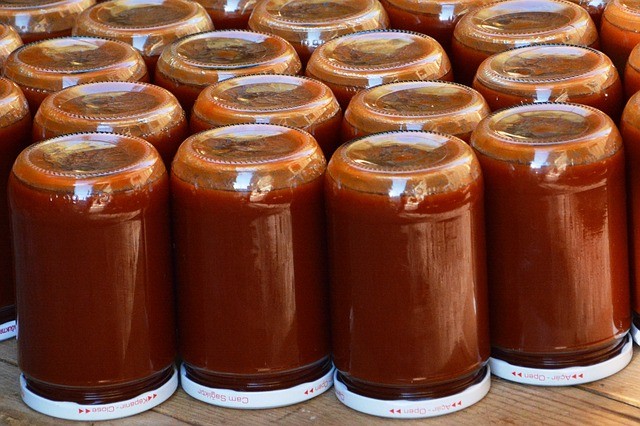
You can eat rosehips straight off the plant by nibbling at the flesh – but avoid the seeds inside. You can cut them in half and scrape out seeds with a fingernail. The flavours is both sweet and citrusy at the same time!
Rosehip Syrup can be made that is packed with vitamin C, and a sweet treat when drizzled over ice cream. To make rosehip syrup, add fresh chopped rosehips to boiling water and allow to simmer for a minute or two. Turn off the heat and let the mixture steep for half an hour. You should get a nice pulpy texture. Strain through a muslin cloth, this may take a little tine so just suspend it above a bowl and allow the juices to seep through. You can repeat the process using the same pulp. Put the liquid into a pan and add brown sugar. Simmer until it is dissolved, and store in sterilised bottles. You can get a better idea of the quantities you need by looking at the recipe in more detail on the printables below.
As well as syrup, Rosehips make a tasty jam or jelly that is superb with cream scones or cakes.
One of my favourite, and quick, ways to use rosehips is as a medicinal herbal tea. Simply dry out your rosehips using one of the methods described earlier. I use a food dehydrator but a warm oven with the door left open works as well. Store in a clean jar, and just add a couple of spoonfuls to a metal tea infuser and let steep for five minutes before drinking.
Rosehip vinegar can be made by slitting the skin of a few rosehips. Add to a clean jar and pour over some apple cider vinegar. Leave to infuse for about four weeks, before straining. You may have already heard about the health benefits of apple cider vinegar, but now you have it with the added vitamins and nutrients provided by the rose hips. Use how you would usually use apple cider vinegar, such as adding drops to water as a tonic, or making tasty salad dressings.
You may have often seen rosehips in the hedgerows and wondered what you could do with them. I hope this has given you some autumn foraging ideas, and the confidence to give rosehips a try if you haven’t done so before.
6. Sloes
Now this is an autumn fruit that is abundant in hedgerows, and they are the fruits of blackthorn trees or bushes. This plant is Native to Europe, North Africa and West Asia, yet is also naturalised in Eastern North America and New Zealand.
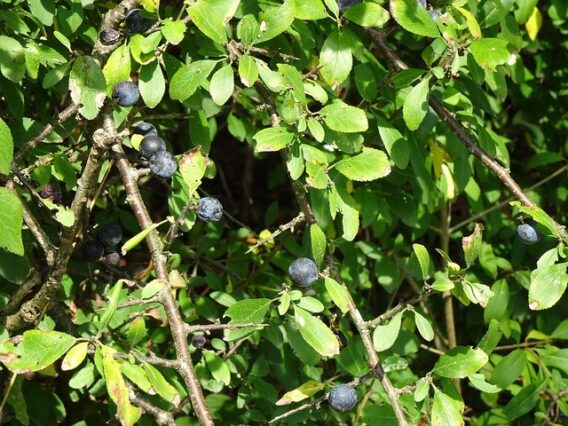
So let’s get straight into how to identify and use this versatile wild berry that is easy to find for autumn foraging.
Identifying Sloes
Blackthorn trees are low growing, and have a crooked, gnarly look to them. It doesn’t get its name for nothing. All along the woody stems are long, sharp thorns. They are strong too, and can pierce through clothing.
The leaves of blackthorn are small green ovals, and during springtime, blackthorn erupts with white flowers, which are in fact also edible!
The sloe berries appear in autumn, and shine bright blue in colour. This is due to a natural yeast that coats the berry, and when it is rubbed off, it reveals a dark shiny skin underneath. The flesh inside is green, and a little taste will reveal a mouth drying sourness that is unmistakable.
Sloe Picking Tips
Take care when picking sloes, the woody thorns are very sharp! You could wear a good set of gardening gloves, have long sleeves on, or just be very careful.
Make sure you pick ripe fruits for the best flavour. The colour should be a rich, dark purple, and the flesh should squash when you press it. If a few have begun to fall off the bush, then that is also a good indicator that they are ripe.
For the juiciest fruits, wait until there has been a frost before picking.
Nutritional Benefits of Sloes
There are some good health benefits to be had from eating sloes. They have lots of vitamin C and tannins.
Steeping the flowers in water makes a soothing wash you can gargle with to help relieve sore throats and tonsils, and reduces inflammation in the mouth.
Tea made from leaves and blossom soothes coughs and sore throats. It is also a mild laxative, and stimulates the appetite.
The bark of blackthorn trees is an astringent, the helps to contract and shrink tissue in the body. A decoction made from the bark helps wounds to heal when applied topically, and can be used to treat piles.
Blackthorn Wild Crafting and Folklore
Blackthorn wood is great for carving, and for making walking sticks.
The juice from the berries makes a strong, dark dye that can be used to colour fabrics.
In many types of European folklore, the blackthorn tree has associations with witchcraft.
It is also associated with protection, due to the impenetrable shield of thorns it produces.
Sloe Recipe Suggestions
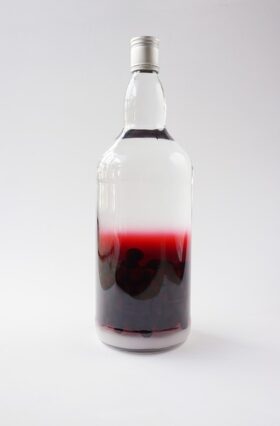
Sloes are traditionally used to flavour beverages, and it compliments gin very well.
To make sloe gin, gather and wash fruits. Prick each one several times with a pin to help release the juices.
Divide your gin between two suitably sized glass jars, and add your fruit and a little sugar.
Put lids on and gently shake. Leave the sloes in the gin for at least three months, and you can leave for up to six. Shake the jars daily to get all the goodness and flavour from the sloes to infuse with the gin. Add sugar to taste, but make sure it is all dissolves before your gin is finished.
When you are happy with the taste, strain through a muslin cloth to remove the fruit and sediments. Decant into attractive bottles to make a nice gift, or enjoy for yourself!
After you’ve made your sloe gin, the boozy fruits can be used in all sorts of desserts too.
Sloe berries can also be used with other fruits to make a jelly to go with rich meats. Sloes are full of natural pectin, so adding a few sloes to any jelly or jam will help it to set.
To get all the health benefits from these berries without adding sugar is difficult, as sloe berries are very tart. However, you could mix with sweeter fruits such as apples and make a fruit paste or quick chutney to go with cheese. So there we have the sloe berry, a bitter fruit that can be put to good culinary use.
7. Wild Plums
Wild plums are a great addition to autumn foraging fayre. They are interesting because there are many different varieties and sub species, due to how easily plum trees cross-pollinate. As a forager, you are likely to come across many types of small plums, either purple or yellow, in a variety of countryside, urban and suburban environments.
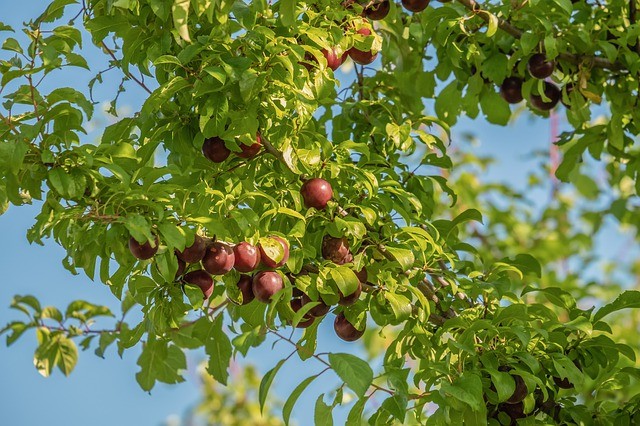
I always find that wild plum trees tend to blend in well with other trees and shrubs around them, and often the first sign is a few squashed plums on the floor that get your attention!
Damsons are one type of wild plum, most commonly found in countryside. They look like regular purple plums, only much smaller. Under the purple skin, the flesh is a greenish yellow.
Bullaces are another type of wild plum, with skin that can be different colours from purple to yellow.
While you might find a few plum trees in the wild, for richer pickings suburban parks or wild areas are often a treasure trove for these tasty fruits. You will often find species that have cross pollinated with domestic plum trees from nearby gardens, producing sweeter tasting plums than that of their wild cousins.
Identifying Wild Plums
Leaves – typically dark green, lightly serrated and oval shaped with a pointed tip.
Flowers – blossom appear in spring, grows in clusters or two or three flowers per stem, and is usually white to pink in colour.
Fruits – smooth oval shaped fruits that can be purple, red, yellow or green in colour. Each fruit contains a stone, which is a large, flattened seed, in the centre. There may be a milky coloured coating on the fruits, which is known as ‘bloom’. This is simply a harmless yeast that covers the fruit and can be wiped off is desired.
Stems – the bark of wild plum trees can be rough and craggy. Leaf stems may have hairs.
Nurtitional Benefits of Wild Plums
Wild plums have a host of health benefits, and have more complex set of nutrients due to their mixed breeding, than that of cultivated plums.
One of the most notable aspects of wild plums is how it can ease digestive complaints such as constipation, as well as provided dietary fibre to help keep things moving in the bowels.
The vitamin C in wild plums helps to boost the immune system and fight of colds and viruses.
Wild plums have good amounts of potassium that can help to reduce high blood pressure.
The red or blue pigments in plum skin contains anthocyanins, powerful antioxidants that can help protect cells from damage, may be beneficial in preventing some cancers, and in slowing down the effects of ageing. They also contain the antioxidant quercetin, which studies have shown slows down the onset of conditions such as Alzeimer’s.* (Harvard Health Research).
Low in calories, plums are a great fruit to aid weight-loss, as well as having a low glycemic index that prevent blood sugar spikes and helps you feel fuller for longer.
Wild Plum Recipes

Wild plums are great to eat raw, although may be sour unless perfectly ripe.
Plum cake is delicious.
Common uses include making preserves such as jams or chutneys to go with cold meats and cheese.
Stewed fruit is great to freeze. One good idea is to freeze in ice cube trays, ready to pop out and enjoy in smoothies, add to yoghurts or porridge, or use as fruit ice in a cooling summer drink.
If you enjoyed this post about autumn foraging, why not join the email list? (no spam!)

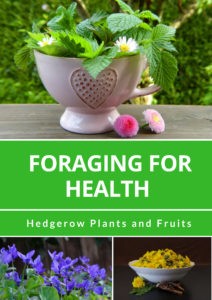
This article helps me to make a decision of making a fruit garden in my home yard. I like the hawthorn that attracts me for its nutritional value. I think it will be great for heart health. Others are looking good also.
Keep up the good posting, Starmer,
Thanks